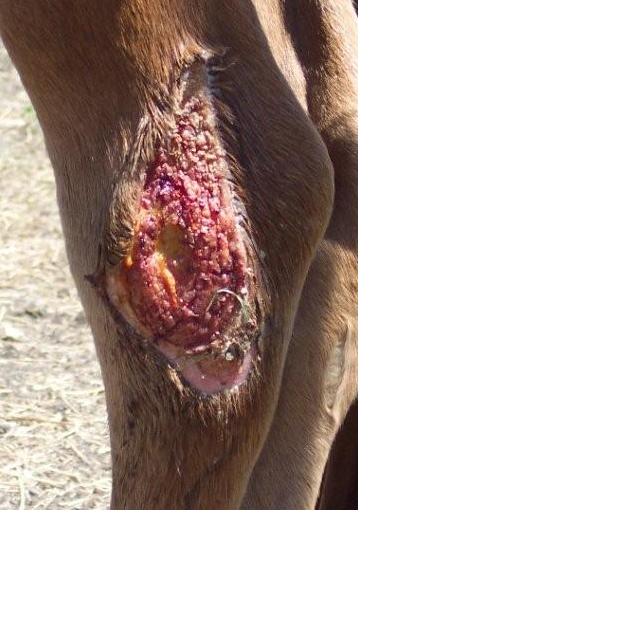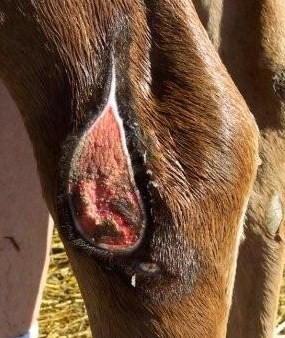Site Menu:
| This is an archived Horseadvice.com Discussion. The parent article and menus are available on the navigation menu below: |
| HorseAdvice.com » Diseases of Horses » Reproductive Diseases » Birthing Problems » Feeding and Caring for the Orphan Foal » |
| Discussion on Rejected Foal - Bite Marks | |
| Author | Message |
| Member: fouch |
Posted on Sunday, May 18, 2008 - 2:06 pm: I have a four-day-old foal that seems to have a new patch of skin missing every time I go to the barn. The most serious of the scrapes is 3" by 5" and deep. I thought the mare had accidently stepped on the colt causing the injury. I have been doctoring the large wound (antibiotics, topicals, etc.) and noticed another patch of skin gone after their turnout. I am now convinced that these are bite marks and not injuries caused by the foal running into something.This is the mares third foal and there has never been a problem in the past. The mare is protective of the foal and I have seen him nurse many times without incident. There appears to be no sign of mastitis or other problems with the mare. I am at a loss as to what to do next. |
| Moderator: DrO |
Posted on Monday, May 19, 2008 - 6:33 am: Hello Scott,If you think the mare is attacking the foal while you are not watching you could try separating the mare and foal in a stall with a barrier the foal can get under but the mare cannot. This gives the foal a "out" if the mare gets to rough. You might also try giving the mare 25 IU of oxytocin each time you see a problem which has been implicated in increasing mare bonding with the foal but this is experimental and alone should not be relied on to protect the foal. Certainly the safest course would be separating them and begin to bottle feed the foal. There is another consideration, there are some congenital skin disorders of foals that present as per your description. For more on these see, Diseases of Horses » Skin Diseases, Wounds, and Swellings » Hair and Coat Problems / Itching / Irritated Skin » Epitheliogenesis Imperfecta (EI) & Hyperelastosis Cutis. DrO |
| Member: fouch |
Posted on Monday, May 19, 2008 - 2:02 pm: I have continued to observe the mare and foal and have seen no aggression (I have a stall camera). Coincidently, just before I got onto the internet my local vet asked my wife if HERDA was a possibility. She can't come out until Thursday, but perhaps I will know more then. Although it doesn't look like there is any test that can be done. My mare traces to Poco Bueno but I am not sure if the stallion does.At least one of the cuts has completely healed. I don't suppose this means that it is not HERDA? Also, the vet wants me to apply a spray called Underwood to the big cut and then put baking powder on the cut. Are you familiar with this product? I have been using Nolvasan and cleaning daily with a garden hose to this point. |
| Member: ekaufman |
Posted on Monday, May 19, 2008 - 2:08 pm: Hi Scott,I wonder if a lightweight foal sheet would help you figure out whether these marks are coming from the skin or from an external cause (the mare or something else). Even a baby fly sheet will usually prevent bites/abrasions. |
| Moderator: DrO |
Posted on Tuesday, May 20, 2008 - 8:29 am: Scott, how does a foal or horse replace a patch of missing skin in less than 6 days?DrO |
| Member: fouch |
Posted on Tuesday, May 20, 2008 - 9:18 am: It was a superficial scrape that healed. The hair has not grown back. The deep wound looks bad and there is significant bleeding when I do the hyDrO therapy. Looked a little better this morning and there are no new cuts. |
| Member: fouch |
Posted on Tuesday, May 20, 2008 - 12:32 pm: Just a followup on the topical my vet wants to use on the large wound. The ingredients are Thymol, Menthol, chloroxylenol .50% copper sulphate, pentahydrate, Wormwood, iodine, acetone, potassium permanganate, FD&C blue no 1, compound tinctures, Potassium iodine. The directions are to not clean the cut and to lightly sprinkle baking powder on the cut after applying the Underwood medicine. |
| Moderator: DrO |
Posted on Wednesday, May 21, 2008 - 7:10 am: Wow Scott pretty caustic stuff in my opinion. I remain uncertain as to the nature and characteristics of the "large wound". Our recommendations are in the articles on Wound First Aid and Long Term Wound care.DrO |
| Member: fouch |
Posted on Friday, May 23, 2008 - 11:42 am: The vet described the injury as blunt force trauma.
|
| Member: ajudson1 |
Posted on Friday, May 23, 2008 - 12:15 pm: Looks like the foal gouged himself on something to me, I see a part that looks deeper than the rest. And if he were my colt, I'd be hosing that wound more than it looks like it's been getting hosed per DrO's wound care instructions of course.Are you sure there are no sharp edges anywheres that he can cut himself on? Do they have a metal barn? Wood? Is he running in a wooded area? Are they locked in a large enough stall when in? Look his world over from his level just like with a toddler! It's amazing what a foal can get hurt on. My first foal from conception had an eye injury that I thought would leave him blind. He either got poked with a sliver of wood or, my guess, the wires which held corner insulators on weren't bent back and he ran into one of them just right. His eye healed but he had a black dot there that never went away. I hope you find some answers, and hope the wound heals all right. How about a full body shot of the little guy? We all love seeing babies! 
|
| Moderator: DrO |
Posted on Friday, May 23, 2008 - 1:14 pm: That is quite a remarkable wound and the location serious as it overlies several joints. You might consider questioning the use of such a caustic mixture as you describe in your previous post and consider a second opinion, if this recommendation persists.As referenced already above we explain our philosophy of wound care in Diseases of Horses » Skin Diseases, Wounds, and Swellings » Wounds / Burns » Long Term Deep Wound Care. DrO |
| Member: fouch |
Posted on Friday, May 23, 2008 - 9:46 pm: I have not used the Underwood. I am using the hyDrOtherapy twice a day and the Nolvasan ointment. I have been unable to keep a bandage on the leg and the wound was getting contaminated with bedding so I have moved them to a small grass pasture. The mare was also going stir-crazy in the stall and, given my previous concerns about the biting, thought it best to get them in a more natural setting.The vet was out last night to cut off some of the dead skin. She said that a good granulation bed had formed and again suggested that I start the Underwood. The wound looked differently this evening and I am concerned about proud flesh forming given the location of the wound. On the other hand, it could just be the healing process. It all looks bad to me. PS. I am pretty much out of vet options in this area. |
| Member: fouch |
Posted on Monday, Jun 9, 2008 - 12:20 pm: Just an update on the foal. I sent a hair sample to Cornell University to test for Herda. Dr. Winand called me shortly thereafter to tell me that the foal is a carrier but that the sores/wounds were not caused by Herda. She said she has seen an alarming number of foals with similar symptoms. Some have deteriorated rapidly and have died while others seem to fight it off and fully recover. At this point her conclusion is that the foal has some type of immune complex disease.I continue to treat the large wound with hyDrO therapy and Nolvasan. The foal has no ulcers in the mouth or on the tongue and seems to be perfectly healthy otherwise. |
| Member: morg1 |
Posted on Monday, Jun 9, 2008 - 3:01 pm: Hi Scott,Years ago my grandparents had a filly that did something similar to this. For the most part both of her hocks were affected the most, but her elbows did this somewhat too. The vet thought is was caused by her being born on limestone. Apparently, he thought, the type of limestone my grandparents had actually burned her skin and caused it to fall off or eat away where it touched the ground the most. It took a long time to heal, but did eventually with very little almost unnoticeable scaring. Just a thought. Karen |
| Moderator: DrO |
Posted on Monday, Jun 9, 2008 - 9:23 pm: Scott, I am sorry to hear things are not much improved and there are still questions, questions that have increased with the finding of heterozygous HERDA. HERDA is thought of as a recessive gene but many gene's expression is not ruled by simple genetics and HERDA is a pretty new disease. I wonder if there are things about the genetic expression of heterozygous HERDA we don't know yet ... the coincidence of having the gene and the clinical signs is striking. Cornell didn't even speculate on this?As far as I am aware immune complex diseases in newborns are pretty dang rare but to follow his best guess diagnosis, have you started immunosuppressive doses of corticosteroids? DrO |
| Member: fouch |
Posted on Saturday, Jun 14, 2008 - 11:20 am: Dr. Winand told me that most of the other foals that have had similar symptoms did not test as carriers. The foals that lived past two weeks seem to have fully recovered. Attached is a picture at 28 days. I have done hyDrO therapy two times a day and applied Nolvasan.
|
| Moderator: DrO |
Posted on Monday, Jun 16, 2008 - 7:25 am: It does seem to be closing nicely Scott and glad to hear the vet believes this will be OK.DrO |
Horseadvice.com
is The Horseman's Advisor
Helping Thousands of Equestrians, Farriers, and Veterinarians Every Day
All rights reserved, © 1997 -
is The Horseman's Advisor
Helping Thousands of Equestrians, Farriers, and Veterinarians Every Day
All rights reserved, © 1997 -
